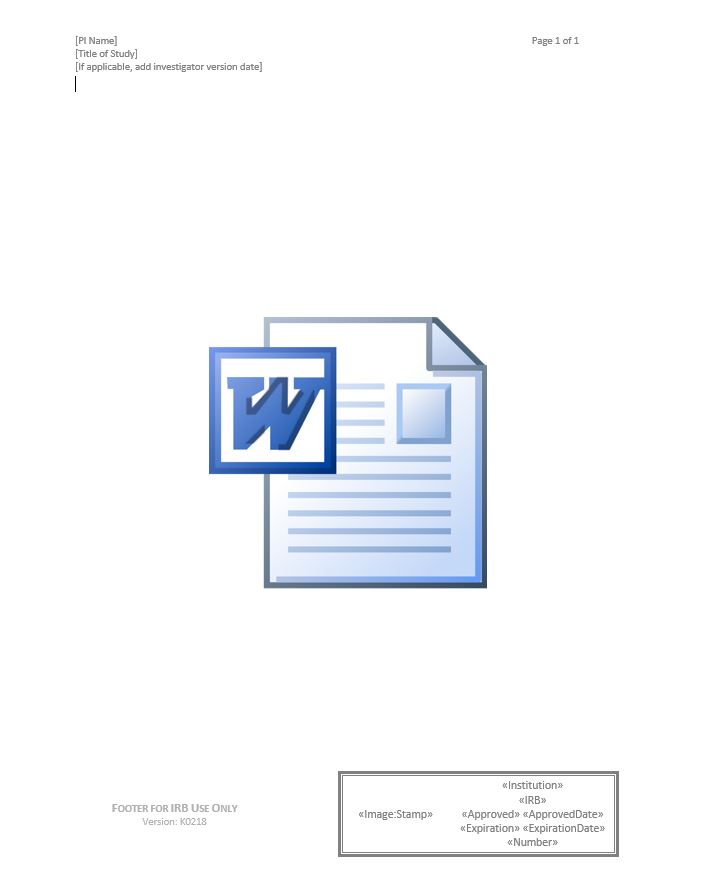How will Consent be Documented in the Research Record?
A participant's consent must be documented in the research record as proof that the participant:
- Was given the choice to participate,
- Was given the necessary information about the study, and
- Gave his/her affirmative consent before beginning the study.
Consent (and authorization) are commonly documented by obtaining a signature from the participant and then keeping the signed document in the research record. A copy of the signed document must also be given to the participant.
There are instances when the participant cannot give legally effective consent for him/herself, such as when the participant is under the age of 18 or is cognitively impaired. There are also instances when getting a signature is not reasonable or practical.
Printer-Friendly
Consent Document Checklist
A printer-friendly version of our consent document checklist is available here.
Click below to read more about each of the requirements.
Additional Considerations for Documenting Consent
The sections below describe instances when the common method of documenting consent with a signature requires additional considerations or is not reasonable or practical.
Parental Permission and Assent
When a participant is a child, under the age of 18, documentation of consent must be obtained from the parent(s). Additionally, assent may be required for children ages 7-17. Please review the following Investigator Guidance Series documents that provide in depth information about the parental permission and assent processes:
- Research Involving Children
- Parental Permission and Child Assent
- Research Involving Wards of State
Consent Using a Legally Authorized Representative (LAR)
When a participant is cognitively or decisionally impaired, he/she may not be able to understand the study information and consent process presented. In these cases, documentation of consent must be obtained a legally authorized representative of the participant. Additionally, assent may be required for adults who are cognitively/decisionally impaired but can understand the study well enough to provide assent. Please review the following Investigator Guidance Series documents that provide in depth information about the LAR consent and participant assent processes:
- Research Involving Individuals with Decisional Impairment
- Surrogate Consent by a Legally Authorized Representative
Consent for Participants with Limited English Proficiency (LEP)
When a participant does not speak English, consent documentation must include proof that the consent process and elements were provided in the participant's language. This means that consent documents must be translated into the language understood by the participant.
A translator with appropriate language expertise must translate the consent documents. The translator certifies his/her translation by writing a letter to describe his/her qualifications for the translation. A template Translation Certification Letter can be found on the IRB Forms pages.
There are situations when a translation of the consent document cannot be obtained. In these cases, the IRB may consider it appropriate to use a translated short form in combination with an oral interpretation of the full English consent document. A short form is like a cover letter to the full consent form, telling the participant what to expect during the oral consent process discussion of the study. When using the short form process to obtain and document consent, strict rules must be followed according to the federal regulations, described in the Short Form Instructions for Use. Pre-translated short forms are available on the IRB Forms pages.
In most cases, and in all cases when using the short form, a qualified interpreter must assist in the consent process. Members of the study team who are fluent in a participant's language may also provide interpretation. Investigators must be sure that the individuals providing interpretation and translation services have appropriate medical/scientific language skills to accurately communicate the details of the study.
Consent Without a Signature
Consent without a signature can only be approved by an IRB in the following situations:
- The only record linking the subject and the research would be the consent document and the principal risk would be potential harm resulting from a breach of confidentiality.
- In this scenario, each participant must be asked whether he/she would like to sign a consent document. If the participant declines to sign, but voices consent verbally, he/she can still be in the study.
- The research presents no more than Minimal Risk of harm to subjects and involves no procedures for which written consent is normally required outside of the research context.
-
Participants in this study are members of a distinct cultural group or community in which signing forms is not the norm. The research presents no more than Minimal Risk of harm to subjects and the study team has an alternative mechanism for documenting that informed consent was obtained.
Consent without a signature requires that a waiver of documentation of consent be requested in the IRB application. The IRB application asks for justification according to the situations above.
In many cases, it is still appropriate to provide the participant with written information about the study, discussing the required consent elements. This is often done using a consent cover letter; a model consent cover letter can be found further down on this page.
When a signature is not obtained, another method must be used to document consent in the research record. Consider the consent process example scenarios below for additional methods of consent documentation.
Opt-Out Consent Model
An opt-out consent model is one where consent is assumed unless the participant actively dissents if they wish to be excluded from the study. Opt-out models may be considered based on the nature of a research project. For example, it may be acceptable to inform parents of research conducted at an elementary or secondary school and use an opt-out model if a parent wishes to have their child excluded from the study. The requirements for a waiver of parental permission must be met and the school or school district must approve of this method. See Consent Process Models, for a description of this consent example scenario.
Preparing Your Documents for Submission to the IRB
The IRB stamps consent documents after approval. Investigators should ensure that the document is prepared for electronic stamping of consent documents. The University of Utah IRB strives to allow for flexibility in the format of consent documents. The following guidelines should be followed.
SAMPLE CONSENT DOCUMENTS
The IRB provides sample consent documents that may help investigators to design their
own consent documents. The samples below contain all of the consent elements and local
requirements for the study for which they were originally designed. Use of these samples
does not guarantee the IRB will approve similar consent documents designed for other
studies.
NOTE: These documents are for example only and should not be attached to your ERICA submission.
Make sure your document includes the required footer formatting (see: "Preparing Documents
for Submission" above).
Consent & Authorization Models
Title |
Description |
File |
| Biomedical Clinical Trial |
|
WORD VERSIONPDF VERSION |
| Prospective, Observational |
|
WORD VERSIONPDF VERSION |
| Prospective, Randomized |
|
WORD VERSIONPDF VERSION |
| Concise Summary Examples |
|
WORD VERSIONPDF VERSION |
| Consent Cover Letter & Authorization |
|
WORD VERSIONPDF VERSION |
Consent Models
TITLE |
DESCRIPTION |
FILE |
| Consent Cover Letter |
|
WORD VERSIONPDF VERSION |
| Consent Document |
|
WORD VERSIONPDF VERSION |
Parental Permission Models
TITLE |
DESCRIPTION |
FILE |
| Consent + Parental Permission |
|
WORD VERSIONPDF VERSION |
| Parental Permission & Authorization |
|
WORD VERSIONPDF VERSION |
Assent Models
TITLE |
DESCRIPTION |
FILE |
| Age 7-11 |
|
WORD VERSION PDF VERSION |
| Age 12-17 |
|
WORD VERSIONPDF VERSION |
| Minimal Risk |
|
WORD VERSIONPDF VERSION |
VA Consent Models
TITLE |
DESCRIPTION |
FILE |
| Greater Than Minimal Risk |
|
WORD VERSIONPDF VERSION |
| Minimal Risk |
|
WORD VERSIONPDF VERSION |
| Minimal Risk 2 |
|
WORD VERSIONPDF VERSION |
| Consent & Authorization |
|
WORD VERSIONPDF VERSION |
References
- DHHS Common Rule, Documentation of Informed Consent: 46 CFR 46.117
- FDA, Documentation of Informed Consent: 21 CFR 50.27
- VHA Handbook, 1200.05: Requirements for the Protection of Human Subjects in Research


